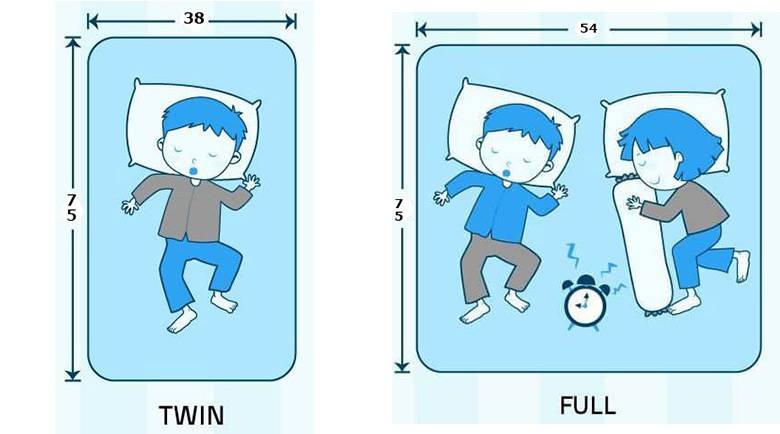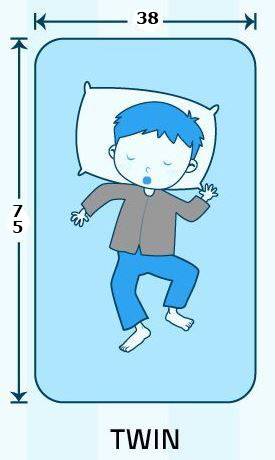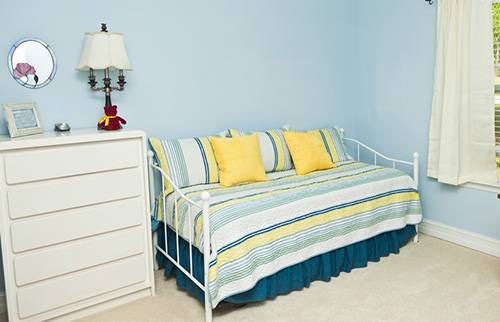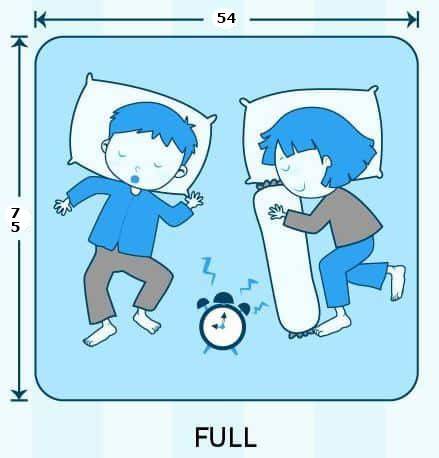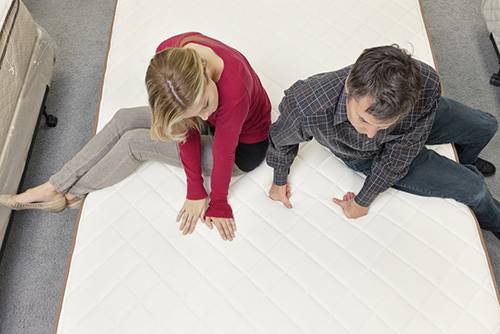
A twin size bed is often what most people start out with as a child and teenager, and many adults see no reason to size up until they own their own home or marry. However, a twin or even a twin XL may not be spacious enough for a growing teen and choosing a slightly larger size may be worth the investment. Twin vs full mattresses highlight a slight difference in overall size, but the difference it makes can be notable towards a better night’s sleep.
| Twin | Twin XL / Full |
|
|
What is a Twin Bed?
Also called a single mattress, the twin size mattress can come in two sizes: a standard twin, or twin XL. The main difference between these two are length, with a standard measuring 38 inches wide, and 75 inches long. An XL has an additional 5 inches in length for a total of 80 inches.
Most twin mattresses have a low profile as well and maybe anywhere from 5 to 10 inches thick, with most falling between 6 and 8 inches in height.
— Who is A Twin Mattress Best For?
75 inches fits a maximum of 5’8” person comfortably, but maybe a bit too small for anyone taller. The 80 inches of the XL generally fit a 6’2” tall person well, but these lengths, combined with the lower profiles are designed for an overall smaller, lightweight body.
Twin mattresses are often the perfect fit for growing children and teens. They are long enough to support adolescents, and also sturdy enough to last under the changing weight and body shape of this growth. The thinner the mattress, the less weight it can support overall comfortably, so many people may choose to consider sizing up as they reach maturity.
— Benefits of a Twin Mattress
The more compact size of a twin is conducive to smaller rooms, as well as children’s rooms that often double as a playroom. Many times, children share a bedroom as well, and twin mattresses allow multiple children to have their own bed space in the form of bunk beds, lofts, or other stackable options. The smaller profile choices are also perfect for this as well since most stacking options require a 6 inch or less profile and only support up to 150 lbs overall.
They also work well for small bedroom areas and can double as a daybed or even futon as a guest option when needed. Their narrow measurement doesn’t take up too much space, and fits well into apartment living situations. This includes loft and studio apartments that are compact in nature.
— Twin Mattress Problems
Obviously, their overall size is probably the only real issue. At a little over 3 feet wide, this doesn’t leave a lot of room to stretch out. Plus, the standard length can also be problematic for taller bodies. This is especially true of some growing teenagers.
They also are definitely not designed for more than one person, and if you are a couple, this is not the bed size for you. This is also true if you have an animal that likes to sleep with you. Add a medium-sized dog to the mix, and you might be a little pressed for space.
What is a Full Bed?
A full-size mattress, also known as a double, measures a bit larger than a twin- coming in at 54 inches by 75 inches. This size bed used to be the most popular for average size couples, but now is seen more as a more roomy option for single sleepers. They are a cozy and comfortable option, and at 4.5 feet wide, it is great for those who are 5’8” tall or shorter.
These generally can be found in a low to average profile as well to support a wider range of body weight and sizes. 8 to 12-inch mattress depths are common in this size, which can support up to around 250 lbs or more depending on the thickness.
— Who Is A Full Mattress Best For?
Smaller to average-sized couples may find a full mattress to be all they need. If they don’t move much through the night and don’t mind the closer proximity of another sleeper, this is a good way to go. Otherwise, a full is a great size for a young growing adult, and also serves as a great choice for smaller rooms, apartments, and as a guest bed option.
It also is a great choice for anyone who has a pet that likes to curl up with you at night. With plenty of room for a single sleeper, it leaves enough space for most average to larger size dogs as well (as long as they aren’t bed hogs!).
— Benefits of a Full Mattress
As mentioned above, these are also a compact bed choice and truly are turned to when something larger, such as a queen or king is simply too large for the space it needs to go in- yet a twin is too small for the sleeper. It is not as popular as it once was, but it certainly has its benefits overall and provides the space and comfort needed without taking up too much room.
— Full Mattress Problems
Like the twin, the size of a full mattress has a tendency to be the biggest problem. It may work great for an individual sleeper, but if they are taller, it may be a tad bit too short. It also may be slightly too narrow overall for a couple, especially if they like to turn and spread out through the night.
Conclusion
Overall, both twin and full mattresses are popular with single sleepers. The twin and twin xl are excellent options for more compact areas, or growing children, while the full is preferred by adults, or even close sleeping couples. The smaller dimensions make them both the perfect pick for smaller bedrooms or living areas, as well as their biggest downfall.
